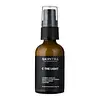What's inside
What's inside
 Key Ingredients
Key Ingredients

 Benefits
Benefits

 Concerns
Concerns

No concerns
 Ingredients Side-by-side
Ingredients Side-by-side

Water
Skin ConditioningAscorbyl Tetraisopalmitate
AntioxidantPropanediol
SolventCaprylic/Capric Triglyceride
MaskingIsoamyl Laurate
EmollientPolyglyceryl-6 Stearate
EmollientTocopherol
AntioxidantSilanetriol
Adenosine
Skin ConditioningSh-Oligopeptide-1
Skin ConditioningSh-Oligopeptide-2
Skin ConditioningSh-Polypeptide-1
Skin ConditioningSh-Polypeptide-9
Skin ConditioningSh-Polypeptide-11
Bacillus
Skin ConditioningSodium Hyaluronate
HumectantAllantoin
Skin ConditioningNicotiana Benthamiana Hexapeptide-40 Sh-Polypeptide-47
Skin ConditioningXanthan Gum
EmulsifyingGlyceryl Stearate
EmollientPolyglyceryl-6 Behenate
Emulsion StabilisingCaprylyl Glycol
EmollientButylene Glycol
Humectant1,2-Hexanediol
Skin ConditioningLecithin
EmollientAcetyl Glutamine
Skin ConditioningDisodium EDTA
Pentylene Glycol
Skin ConditioningGlycerin
HumectantDehydroacetic Acid
PreservativeBenzyl Alcohol
PerfumingWater, Ascorbyl Tetraisopalmitate, Propanediol, Caprylic/Capric Triglyceride, Isoamyl Laurate, Polyglyceryl-6 Stearate, Tocopherol, Silanetriol, Adenosine, Sh-Oligopeptide-1, Sh-Oligopeptide-2, Sh-Polypeptide-1, Sh-Polypeptide-9, Sh-Polypeptide-11, Bacillus, Sodium Hyaluronate, Allantoin, Nicotiana Benthamiana Hexapeptide-40 Sh-Polypeptide-47, Xanthan Gum, Glyceryl Stearate, Polyglyceryl-6 Behenate, Caprylyl Glycol, Butylene Glycol, 1,2-Hexanediol, Lecithin, Acetyl Glutamine, Disodium EDTA, Pentylene Glycol, Glycerin, Dehydroacetic Acid, Benzyl Alcohol
Water
Skin ConditioningPropanediol
SolventButylene Glycol
HumectantDiglycerin
HumectantGlycerin
Humectant1,2-Hexanediol
Skin ConditioningAscorbyl Glucoside
Antioxidant3-O-Ethyl Ascorbic Acid
Skin ConditioningPolysorbate 20
EmulsifyingSodium Citrate
BufferingXanthan Gum
EmulsifyingSodium Hydroxide
BufferingDipotassium Glycyrrhizate
HumectantNiacinamide
SmoothingMaltodextrin
AbsorbentCitric Acid
BufferingSucrose Dilaurate
EmollientSodium Cocoyl Glutamate
CleansingPisum Sativum Extract
Skin ConditioningWater, Propanediol, Butylene Glycol, Diglycerin, Glycerin, 1,2-Hexanediol, Ascorbyl Glucoside, 3-O-Ethyl Ascorbic Acid, Polysorbate 20, Sodium Citrate, Xanthan Gum, Sodium Hydroxide, Dipotassium Glycyrrhizate, Niacinamide, Maltodextrin, Citric Acid, Sucrose Dilaurate, Sodium Cocoyl Glutamate, Pisum Sativum Extract
 Reviews
Reviews

Ingredients Explained
These ingredients are found in both products.
Ingredients higher up in an ingredient list are typically present in a larger amount.
1,2-Hexanediol is a synthetic liquid and another multi-functional powerhouse.
It is a:
- Humectant, drawing moisture into the skin
- Emollient, helping to soften skin
- Solvent, dispersing and stabilizing formulas
- Preservative booster, enhancing the antimicrobial activity of other preservatives
Butylene Glycol (or BG) is used within cosmetic products for a few different reasons:
Overall, Butylene Glycol is a safe and well-rounded ingredient that works well with other ingredients.
Though this ingredient works well with most skin types, some people with sensitive skin may experience a reaction such as allergic rashes, closed comedones, or itchiness.
Learn more about Butylene GlycolGlycerin is already naturally found in your skin. It helps moisturize and protect your skin.
A study from 2016 found glycerin to be more effective as a humectant than AHAs and hyaluronic acid.
As a humectant, it helps the skin stay hydrated by pulling moisture to your skin. The low molecular weight of glycerin allows it to pull moisture into the deeper layers of your skin.
Hydrated skin improves your skin barrier; Your skin barrier helps protect against irritants and bacteria.
Glycerin has also been found to have antimicrobial and antiviral properties. Due to these properties, glycerin is often used in wound and burn treatments.
In cosmetics, glycerin is usually derived from plants such as soybean or palm. However, it can also be sourced from animals, such as tallow or animal fat.
This ingredient is organic, colorless, odorless, and non-toxic.
Glycerin is the name for this ingredient in American English. British English uses Glycerol/Glycerine.
Learn more about GlycerinPropanediol is an all-star ingredient. It softens, hydrates, and smooths the skin.
It’s often used to:
Propanediol is not likely to cause sensitivity and considered safe to use. It is derived from corn or petroleum with a clear color and no scent.
Learn more about PropanediolWater. It's the most common cosmetic ingredient of all. You'll usually see it at the top of ingredient lists, meaning that it makes up the largest part of the product.
So why is it so popular? Water most often acts as a solvent - this means that it helps dissolve other ingredients into the formulation.
You'll also recognize water as that liquid we all need to stay alive. If you see this, drink a glass of water. Stay hydrated!
Learn more about WaterXanthan gum is used as a stabilizer and thickener within cosmetic products. It helps give products a sticky, thick feeling - preventing them from being too runny.
On the technical side of things, xanthan gum is a polysaccharide - a combination consisting of multiple sugar molecules bonded together.
Xanthan gum is a pretty common and great ingredient. It is a natural, non-toxic, non-irritating ingredient that is also commonly used in food products.
Learn more about Xanthan Gum